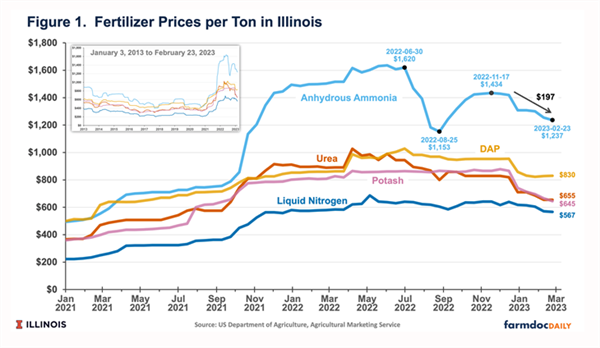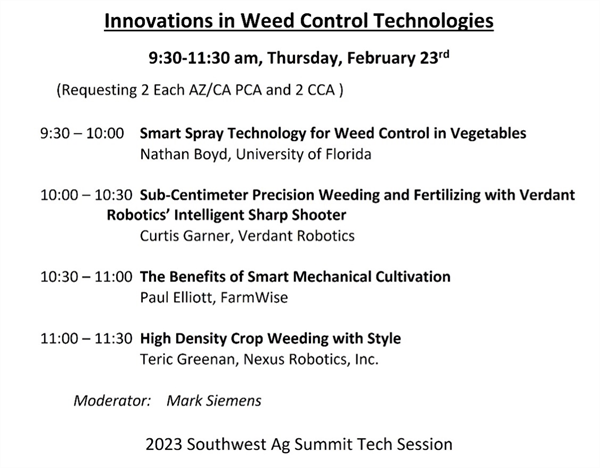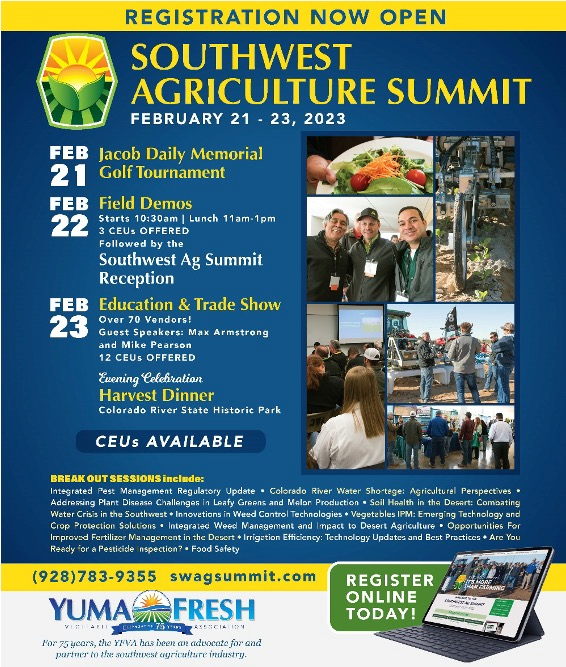
These large fluctuations have been largely due to changes in trade flows with Russia because of the tensions in the region, sanctions imposed on Russia, inflation, and other pandemic-related complications with transportation logistics. Collectively, expensive fertilizer prices have been a challenge globally and certainly in our crop production systems of the desert Southwest.
Recently, several retail fertilizers have varied significantly in the market trends. For example, in May 2023 about half of the major retail fertilizers are higher compared to April prices and the other half has lower prices than last month (Quinn, 2023).
Urea (46-0-0) has gone up 6% in retail markets since last month with an average price of $664/ton. A few weeks ago, urea was below $600/ton for the first time since late 2021. Similarly, diammonium phosphate (18-46-0), monoammonium phosphate (11-52-0), and urea ammonium nitrate (32-0-0) had an average the past month of $517/ton.
In contrast, anhydrous ammonia (82-0-0) has had an average price recently of $910/ton, which is down about 9% in price from April 2023. Several other major fertilizers have been lower in price the past month. Muriate of potash (KCl, 0-0-60) had an average price in the past month of $627/ton, ammonium polyphosphate (10-34-0) average price has been $739/ton, and urea ammonium nitrate (UAN-32, 32-0-0) average price has been $423/ton this month.
Note that several of the major fertilizer materials come in different forms. For example, urea ammonium nitrate (UAN) is 28% N in some materials and 32% N in another common form. Also, monoammonium phosphate (MAP) can have N concentrations of 10-12% and P2O5 concentrations of 48-61% with 11-52-0 being probably the most common form in the market.
Considering the overall trends in the past few years, international fertilizer prices have been generally decreasing since the summer of 2022. Today, international fertilizer prices are back in a range close to early 2021. International fertilizer prices are not expected to drop below pre-pandemic levels, primarily due to global inflation that generates an increase in production and transportation costs (Figure 1).
Several expert sources in the fertilizer industry are projecting a drop in international fertilizer prices in the coming months by approximately 50% of the prices experienced last year. Accordingly, many fertilizer importers are waiting to ship to markets and farmers are often waiting and watching for the projected drop in fertilizer prices to materialize before purchasing (Schnitkey et al., 2023).
Despite the high degree of volatility in international fertilizer markets and the limited availability of fertilizers in some crop production sectors that have recently been experienced, it is expected that the downward trends will continue.
Looking ahead, many experts in the international fertilizer industry are recommending for producers to not wait until too late to purchase fertilizers for upcoming crops, utilize economies of scale when purchasing fertilizers materials as much as possible, and of course watch the trends in fertilizer markets. International logistics in the fertilizer industry, including shipping, transfer, and distribution of fertilizer cargo is proving to be very important in realizing a more stable fertilizer market for the future.

Figure 1. Example of fluctuations in fertilizer prices per ton of material from
January 2021 through March 2023. Source: Schnitkey et al. 2023
References:
Schnitkey, G., N. Paulson, C. Zulauf and J. Baltz. 2023. Fertilizer Prices and Company Profits Going into Spring 2023. farmdoc daily (13):36, Department of Agricultural and Consumer Economics, University of Illinois at Urbana-Champaign, 28 February 2023.
Quinn, R. 2023. DTN Retail Fertilizer Trends: Fertilizer prices moving in two directions. DTN Newsletter, 17 May 2023. https://www.dtnpf.com/agriculture/web/ag/crops/article/2023/05/17/fertilizers-moving-two-directions
I hope you are frolicking in the fields of wildflowers picking the prettiest bugs.
I was scheduled to interview for plant pathologist position at Yuma on October 18, 2019. Few weeks before that date, I emailed Dr. Palumbo asking about the agriculture system in Yuma and what will be expected of me. He sent me every information that one can think of, which at the time I thought oh how nice!
When I started the position here and saw how much he does and how much busy he stays, I was eternally grateful of the time he took to provide me all the information, especially to someone he did not know at all.
Fast forward to first month at my job someone told me that the community wants me to be the Palumbo of Plant Pathology and I remember thinking what a big thing to ask..
He was my next-door mentor, and I would stop by with questions all the time especially after passing of my predecessor Dr. Matheron. Dr. Palumbo was always there to answer any question, gave me that little boost I needed, a little courage to write that email I needed to write, a rigid answer to stand my ground if needed. And not to mention the plant diagnosis. When the submitted samples did not look like a pathogen, taking samples to his office where he would look for insects with his little handheld lenses was one of my favorite times.
I also got to work with him in couple of projects, and he would tell me “call me John”. Uhh no, that was never going to happen.. until my last interaction with him, I would fluster when I talked to him, I would get nervous to have one of my idols listening to ME? Most times, I would forget what I was going to ask but at the same time be incredibly flabbergasted by the fact that I get to work next to this legend of a man, and get his opinions about pest management. Though I really did not like giving talks after him, as honestly, I would have nothing to offer after he has talked. Every time he waved at me in a meeting, I would blush and keep smiling for minutes, and I always knew I will forever be a fangirl..
Until we meet again.
Interested in the latest developments in automated weeding machines? There are a couple of opportunities at the upcoming 2023 Southwest Ag Summit to stay up to date. The first is the “Innovations in Weed Control Technologies” breakout session where university experts and cutting-edge innovators will provide updates on the latest advances in high precision smart spot sprayers, autonomous ag robots and towed automated weeders (agenda below). The session will be held Thursday, February 23rd from 9:30-11:30 am at Arizona Western College (AWC) in Yuma, AZ. The other is the Southwest Ag Summit Field Demo on February 22nd, where several of these technologies and other state-of-the-art automated weeders will be demonstrated operating in the field. The Field Demos will also be held at AWC and begin at 10:30 am.
For more information about the Southwest Ag Summit, visit https://yumafreshveg.com/southwest-ag-summit/. Please note that at the time of this writing, the website has some incorrect dates and programming information. It will be updated soon, so please check back for accurate information. The flyer below has the correct dates (Fig. 2).

Fig. 1. Agenda for the “Innovations in Weed Control Technologies” educational
session at the 2023 Southwest Ag Summit. Session will be held Thursday,
February 23th at Arizona Western College, Yuma, AZ.

Fig. 2. 2023 Southwest Ag Summit flyer. Event will be held at Arizona
Western College in Yuma, AZ.
We published this booklet last July. Please let us know what you think by responding our five questions in the link provided below. The first 25 respondents WILL RECEIVE a copy of the guide. Additionally…first five to take the survey and ID the weeds in the cover of the booklet will also get a Navy Blue UA Vegetable IPM HAT.
There are abundant resources for weed identification of mature plants. These include very complete guides such as “Weeds of California and Other Western States” by Joseph DiTomaso published by University of California. “An Illustrated Guide to Arizona Weeds” by Kittie F. Parker with excellent drawings by Lucretia Breazeale Hamilton. There are also several phone apps for weed identification. However, the cotyledons of weeds frequently have a different shape than the true leaves, which makes identification of seedlings difficult for some species. The purpose of this pocket booklet is to provide a quick reference with good images that can be carried in your truck to help you identify the most common broadleaved weeds in Southwestern and Central Arizona.
The method for identification presented is not by using a dichotomous key or answering complicated questions about the species. The idea is to leaf through the booklet and find images that match plants you see in the field. If there are unusual characteristics, we note them in our comments for each weed. Here is a link to the guide in PDF format: HERE